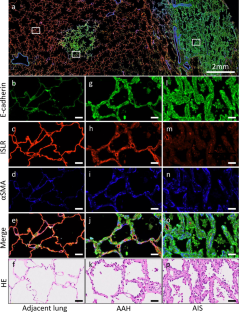International Journal of Clinical Oncology ( IF 3.3 ) Pub Date : 2024-04-11 , DOI: 10.1007/s10147-024-02507-1 Toru Kimura , Takashi Akazawa , Yu Mizote , Harumi Nakamura , Miki Sakaue , Tomohiro Maniwa , Yasushi Shintani , Keiichiro Honma , Hideaki Tahara , Jiro Okami

|
Background
Adenocarcinomas show a stepwise progression from atypical adenomatous hyperplasia (AAH) through adenocarcinoma in situ (AIS) to invasive adenocarcinoma (IA). Immunoglobulin superfamily containing leucine-rich repeat (ISLR) is a marker of tumor-restraining cancer-associated fibroblasts (CAFs), which are distinct from conventional, strongly α-smooth muscle actin (αSMA)-positive CAFs. Fibroblast activation protein (FAP) has been focused on as a potential therapeutic and diagnostic target of CAFs.
Methods
We investigated the changes in protein expression during adenocarcinoma progression in the pre-existing alveolar septa by assessing ISLR, αSMA, and FAP expression in normal lung, AAH, AIS, and IA. Fourteen AAH, seventeen AIS, and twenty IA lesions were identified and randomly sampled. Immunohistochemical analysis was performed to evaluate cancer-associated changes and FAP expression in the pre-existing alveolar structures.
Results
Normal alveolar septa expressed ISLR. The ISLR level in the alveolar septa decreased in AAH and AIS tissues when compared with that in normal lung tissue. The αSMA-positive area gradually increased from the adjacent lung tissue (13.3% ± 15%) to AIS (87.7% ± 14%), through AAH (70.2% ± 21%). Moreover, the FAP-positive area gradually increased from AAH (1.69% ± 1.4%) to IA (11.8% ± 7.1%), through AIS (6.11% ± 5.3%). Protein expression changes are a feature of CAFs in the pre-existing alveolar septa that begin in AAH. These changes gradually progressed from AAH to IA through AIS.
Conclusions
FAP-positive fibroblasts may contribute to tumor stroma formation in early-stage lung adenocarcinoma, and this could influence the development of therapeutic strategies targeting FAP-positive CAFs for disrupting extracellular matrix formation.
中文翻译:

早期肺腺癌肺泡间隔蛋白表达谱的进行性变化
背景
腺癌表现出从非典型腺瘤性增生(AAH)到原位腺癌(AIS)再到侵袭性腺癌(IA)的逐步进展。含有富含亮氨酸重复序列 (ISLR) 的免疫球蛋白超家族是抑制肿瘤的癌症相关成纤维细胞 (CAF) 的标志物,与传统的强 α-平滑肌肌动蛋白 (αSMA) 阳性 CAF 不同。成纤维细胞激活蛋白(FAP)一直被视为 CAF 的潜在治疗和诊断靶点。
方法
我们通过评估正常肺、AAH、AIS 和 IA 中的 ISLR、αSMA 和 FAP 表达,研究了现有肺泡间隔中腺癌进展期间蛋白质表达的变化。确定并随机取样了 14 个 AAH、17 个 AIS 和 20 个 IA 病变。进行免疫组织化学分析以评估癌症相关的变化和预先存在的肺泡结构中 FAP 的表达。
结果
正常肺泡间隔表达 ISLR。与正常肺组织相比,AAH 和 AIS 组织中肺泡间隔的 ISLR 水平降低。 αSMA阳性面积从邻近肺组织(13.3%±15%)到AIS(87.7%±14%),经过AAH(70.2%±21%)逐渐增加。此外,FAP阳性面积从AAH(1.69%±1.4%)逐渐增加到IA(11.8%±7.1%),经过AIS(6.11%±5.3%)。蛋白质表达变化是 AAH 开始的先前存在的肺泡间隔中 CAF 的一个特征。这些变化从 AAH 通过 AIS 逐渐进展到 IA。
结论
FAP 阳性成纤维细胞可能有助于早期肺腺癌的肿瘤基质形成,这可能会影响针对 FAP 阳性 CAF 破坏细胞外基质形成的治疗策略的开发。



























 京公网安备 11010802027423号
京公网安备 11010802027423号